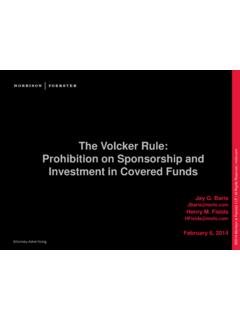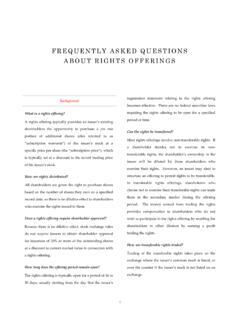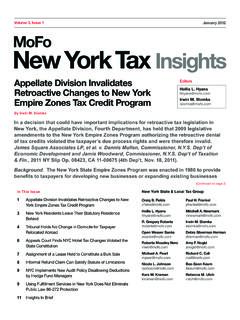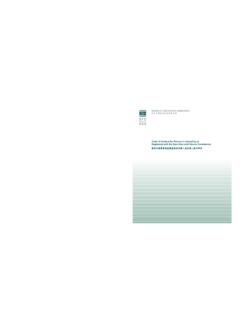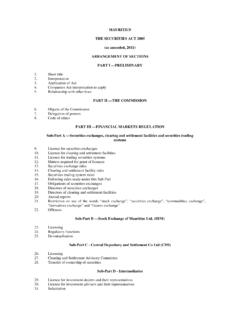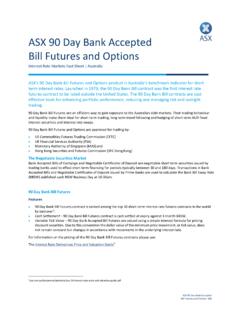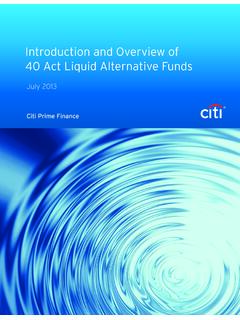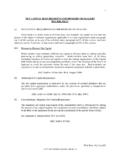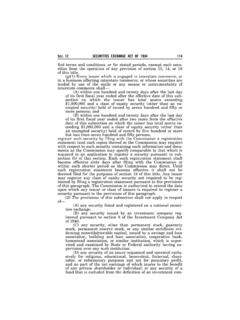Transcription of The Dodd-Frank Act: a cheat sheet - Morrison & Foerster
1 Morrison 1 FoersterMorrison & FoersterThe Dodd-Frank Act:a cheat sheetMorrison 2 FoersterTHE Dodd-Frank WALL STREET REFORM AND CONSUMER PROTECTION ACT, OR Dodd-Frank ACT, REPRESENTS THE MOST COMPREHENSIVE FINANCIAL REGULATORY REFORM MEASURES TAKEN SINCE THE GREAT Dodd-Frank Act implements changes that, among other things, affect the oversight and supervision of financial institutions, provide for a new resolution procedure for large financial companies, create a new agency responsible for implementing and enforcing compliance with consumer financial laws, introduce more stringent regulatory capital requirements, effect significant changes in the regulation of over the counter derivatives, reform the regulation of credit rating agencies, implement changes to corporate governance and executive compensation practices, incorporate the Volcker Rule, require registration of advisers to certain private funds, and effect significant changes in the securitization market. Although the legislation calls for a number of studies to be conducted and requires significant rule-making, we all will be required to be intimately acquainted with the Dodd-Frank the pages that follow, we summarize the principal aspects of the Dodd-Frank Act.
2 As lawyers, we would reflexively say that this is a summary, and only a very brief summary at that, and that all of this is qualified in its entirety by reference to our more complete (and far longer) descriptions and people who receive lots of summaries, we would say short is usually better. We hope you ll find these short summaries 4 FoersterFinancial Stability ReformNumerous government agencies are responsible for regulating financial institutions. Commentators have noted that without a governing body to oversee the various agencies, we remain vulnerable to regulatory gaps and oversight failures. The Dodd-Frank Act creates the Financial Stability Oversight Council ( Council ) to oversee financial of the CouncilChaired by Secretary of Treasury Voting members consist of heads of the Treasury, Federal Reserve, OCC, SEC, CFTC, FDIC, FHFA, NCUA, and the Bureau of Consumer Financial Protection ( Bureau ), as well as an independent member with insurance expertise appointed by the President and confirmed by the SenateNon-voting members include the director of the Office of Financial Research, the director of the Federal Insurance Office, a state insurance commissioner, a state banking supervisor, and a state securities commissionerPurpose of the CouncilIdentifying risks to financial stability that may arise from ongoing activities of large, interconnected financial companies as well as from outside the financial services marketplacePromoting market discipline by eliminating expectations of government bailoutsResponding to emerging threats to financial stabilityDuties of the CouncilCollect information necessary to assess risks to the financial systemProvide direction to the Office of Financial Research to support the work of the CouncilMonitor the financial services market place and identify potential threats to financial stability.
3 As well as regulatory proposals affecting integrity, efficiency, competitiveness, and stability of the financial marketsFacilitate information sharing and coordination among member agencies and other federal and state agenciesRecommend to the member agencies general supervisory priorities and principles reflecting the outcome of discussions among the member agenciesIdentify gaps in regulation that could pose risks to the financial stability of the Federal Reserve supervision for nonbank financial companies that may pose risks to financial stability in the event of their material financial distress or failureReview and submit comments to the SEC and any standard-setting body Morrison 5 Foersterwith respect to an existing or proposed accounting principle, standard, or procedureProvide a forum for discussion and analysis of emerging market developments and financial regulatory issues, and to resolve jurisdictional disputes among members of the CouncilProvide an annual report and testimony before Congress regarding financial stabilityRecommend heightened prudential standards for nonbank financial companies and large, interconnected bank holding companies supervised by the Federal Reserve Recommend to primary financial regulatory agencies new or heightened standards and safeguards for activities that increase risks of significant liquidity, credit, or other problems spreading among bank holding companies, nonbank financial companies, and financial marketsIdentify systemically important financial market utilities and payment, clearing, and settlement activities, and require such utilities and activities to be subject to standards established by the Federal Reserve OtherCreates the Office of Financial Research.
4 Which will support the Council through data collection and researchFinancial companies and nonbank financial companies can appeal Council requirement to implement stricter standardsCouncil must conduct a study on feasibility, benefits, costs, and structure of a contingent capital requirement for nonbank financial companiesCouncil must make recommendations to the Federal Reserve and other federal regulators regarding concentration limits, public disclosures, credit exposure, maintenance of long-term hybrid debt convertible to equity and general financial information reportsIf the applicable agency chooses not to implement any recommendation provided by the Council, it must provide a report explaining its rationaleMorrison 6 FoersterAgencies and Agency Oversight ReformThe various government agencies regulating the financial industry with their varying rules and standards led to certain entities not being regulated at all, with others subject to less oversight than their peer financial firms organized under different charters.
5 The Dodd-Frank Act overhauls the existing agency oversight system as described Agency ChangesCreation of the Financial Stability Oversight Council (Council)Creation of the Office of Financial Research within the Treasury to support the CouncilCreation of an independent Bureau of Consumer Financial Protection (Bureau) within Federal ReserveCreation of the Office of National Insurance within the TreasuryCreation of the Office of Credit Rating Agencies within the SECM ajor Changes in Agency OversightFederal Reserve will regulate thrift holding companies and subsidiaries of thrift holding companies, and will have all rulemaking authority relating to thrift holding companies; Federal Reserve will continue to regulate State member banksThe OCC will regulate national banks and federal thrifts of all sizes, and will have all rulemaking authority relating to thriftsThe FDIC will regulate state thrifts of all sizesThe OTS will be eliminated, all OTS functions, powers, authorities, rights and duties will be transferred to the Federal Reserve, the OCC, or the FDICThe SEC will require registration of hedge funds that manage over $100 million as investment advisers; threshold for investment advisers subject to federal regulation to be raised from $25 million to $100 million Morrison 7 FoersterThe SEC will require registration of municipal financial advisers, swap advisers and investment brokers.
6 Municipal Securities Rulemaking Board rules to be enforced by the SECO therRegulators will be required to implement regulations that prohibit banks, bank holding companies and certain nonbank financial institutions from proprietary trading and investments and sponsorships of hedge funds and private equity fundsFederal Reserve will have rule- making authority (and will act upon recommendations of the Council) with respect to rules prohibiting proprietary trading and investments and sponsorships of hedge funds and private equity fundsLarge complex companies will be required to periodically submit living wills to regulators in the event of financial distressFederal Reserve will be subject to a one- time GAO audit of the Federal Reserve s lending facilitiesMorrison 8 FoersterSecuritization ReformThe final shape of securitization reform is beginning to gel. In addition to the changes effected by the Dodd-Frank Act, the SEC recently released a 667-page proposed rule amending Regulation AB s registration, disclosure, and reporting requirements for asset-backed securities and other structured finance products.
7 And the FDIC released a proposed rule amending its securitization rule safe harbor to require financial institutions to retain more of the credit risk from securitizations and reflect recent accounting changes. This was preceded by the FASB s revisions to accounting rules relating to sales of financial assets and consolidation of certain off-balance sheet entities, revisions to bank capital rules to reflect FASB s accounting changes and the enactment of the Hiring Incentives to Restore Employment Act, which imposes a 30% withholding tax on foreign financial institutions, including certain offshore securitization vehicles. Morrison 9 FoersterCredit Risk Retention5% to be retained by the securitizer; however, if originator retains some amount of risk, only the remaining risk (up to 5% total) will be allocated to securitizerRisk retention also to apply to CDOs, securities collateralized by CDOs and similar instrumentsRisk retention types, forms and amounts for commercial mortgages to be determined by regulators, including permitting a third party that purchases a first-loss position at issuance and who holds adequate financial resources to back losses substituting for the risk retention requirement of the securitizerPercentage retained can be lowered based on underwriting standards usedAn exemption for qualified residential mortgagesOther exemptions will be available at regulators discretionNo hedging or transfer of risk Creation of different asset classes, which may be subject to different regulationsRequired DisclosuresAsset-level or data-level detail, including data with unique identifiers relating to loan brokers or originators, the nature and extent of the compensation of the broker or originator of the assets backing the security.
8 And the amount of risk retention of the originator or securitizer of such assetsFulfilled and unfulfilled repurchase requests across all trusts will be aggregated by the originator, so investors may identify originators with clear underwriting deficienciesDue diligence analysis must be performed by securitizer and provided to investorsRepresentations and WarrantiesCredit rating agencies must explain, in reports accompanying credit ratings, representations, warranties, and enforcement mechanisms available to investors and how they differ from representations, warranties and enforcement mechanisms in similar issuancesOtherRegulations relating to credit risk retention requirements will become effective one year from enactment for residential mortgage assets, and will become effective two years from enactment for all other asset classesThe major elements of securitization reform are: Morrison 10 FoersterTitle VII of the Dodd-Frank Act, to be known as the Wall Street Transparency and Accountability Act of 2010, will impose a comprehensive and far-reaching regulatory regime on derivatives and market participants.
9 Major elements of Title VII are summarized However, many sections of Title VII require various studies to be undertaken and mandate or permit significant rulemaking by the Commodity Futures Trading Commission ( CFTC ), the Securities and Exchange Commission ( SEC ), and various Federal banking regulators. As a result, a full assessment of the impact of Title VII will only be possible once that rulemaking Unless otherwise specified, for convenience we refer to swaps and security-based swaps as swaps, swap dealers and security-based swap dealers as swap dealers, and major swap participants and major security-based swap participants as major swap participants or MSPs. We also use the term applicable regulator to refer to the CFTC, in the case of swaps, and the SEC, in the case of security-based swaps. For a description of the Act s prohibition on proprietary trading, please see our separate summary of the Volcker Rule. Derivatives Regulation Morrison 11 FoersterLincoln Provision (the Swaps Pushout Rule)No Federal assistance ( , advances from any Federal Reserve credit facility or discount window that is not part of a broad-based eligibility program, FDIC insurance, or guarantees) may be provided to any swaps entity ( , swap dealers and non-bank major swap participants, or MSPs).
10 The prohibition does not apply to insured depository institutions that limit their swap activities to (i) hedging and other similar risk mitigating activities directly related to their activities and (ii) engaging in swaps involving rates or reference assets that are permissible for investment by national banks. For purposes of the exception in clause (ii), CDS is permissible only if prohibition only applies to swaps entered into after the end of the transition period, which could be up to five years after Framework and Key DefinitionsThe Act creates parallel regulatory regimes for the CFTC and SEC and divides jurisdiction between the two regulators based on whether a swap or a security-based swap is involved. The CFTC will have jurisdiction over swaps and certain swap market participants, and the SEC will have jurisdiction over security-based swaps and certain security-based swap market participants. Banking regulators will retain jurisdiction over certain aspects of banks derivatives activities ( , capital and margin requirements, prudential requirements).

